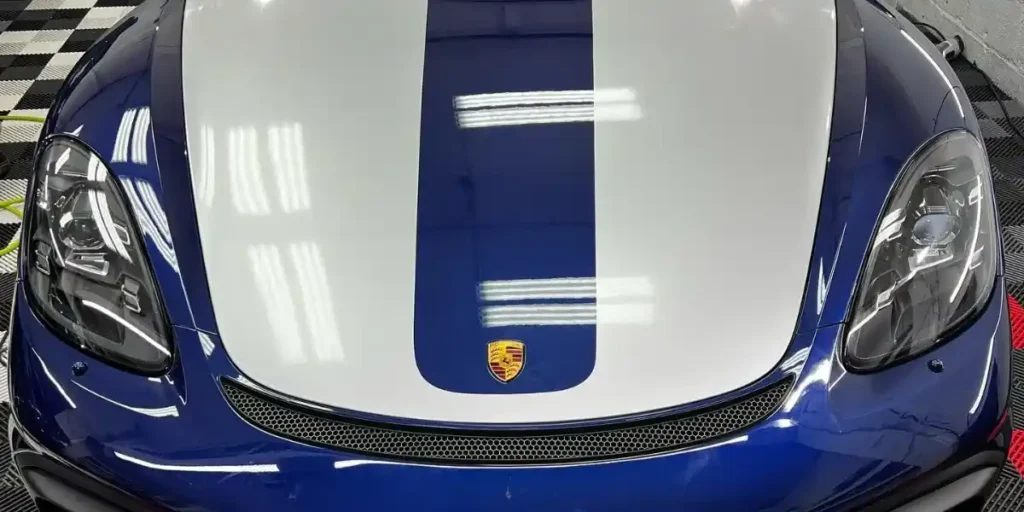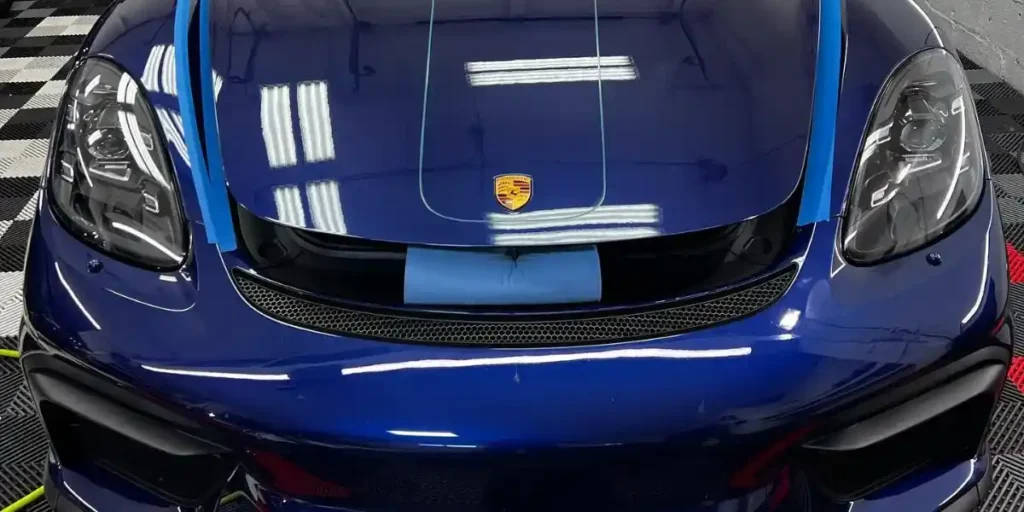Waxing Paint Protection Film (PPF) is renowned for its ability to shield your vehicle’s paint from scratches, chips, and environmental contaminants. However, many car owners overlook a crucial step in maximizing the benefits of PPF: waxing. At Wild Wrapz, we understand the importance of comprehensive vehicle care. Let’s start by discussing why waxing your PPF could be one of the best decisions for your car’s longevity and appearance.
Understanding PPF and Its Benefits
Paint Protection Film (PPF) is a transparent, thermoplastic urethane film applied to a vehicle’s painted surfaces to protect against stone chips, bug splatters, and minor abrasions. Originally developed for military use, PPF has evolved into a popular automotive solution, offering several benefits:
- Physical Protection: Shields paint from scratches, chips, and environmental contaminants.
- Self-Healing Properties: Some PPFs can self-repair minor scratches when exposed to heat.
- UV Resistance: Protects paint from harmful ultraviolet rays, preventing fading and oxidation.
- Enhanced Aesthetics: Maintains the vehicle’s glossy finish, preserving its showroom appearance.
While PPF offers substantial protection, combining it with regular waxing can further enhance its effectiveness and longevity.
The Synergy of Waxing and PPF
Waxing over PPF isn’t just about adding shine; it offers several tangible benefits:
- Enhanced Hydrophobic Properties: Over time, PPF can lose its water-repellent qualities. Applying a suitable wax restores and even enhances these properties, ensuring water beads off effortlessly, reducing water spots, and making cleaning easier.
- Additional UV Protection: While PPF offers UV resistance, certain waxes contain UV inhibitors that provide an extra layer of protection. This dual defense helps maintain the clarity and integrity of both the film and the underlying paint.
- Improved Aesthetic Appeal: Waxing adds depth and gloss to your vehicle’s appearance. Even if your PPF has a matte finish, specific waxes can enrich its look without altering its intended finish.
- Extended Lifespan of PPF: Regular waxing reduces the accumulation of contaminants on the PPF surface, minimizing the risk of staining or degradation. This maintenance routine can significantly extend the life of your PPF investment.
Choosing the Right Waxing Paint Protection Film
Not all waxes are suitable for use on PPF. It is essential to choose products that meet the following criteria:
- Non-Abrasive: Avoid waxes with abrasive compounds that can scratch or dull the film.
- Free from Harsh Solvents: Steer clear of waxes containing naphtha or kerosene, as they can compromise the film’s integrity.
- Designed for Clear Coats: Opt for waxes specifically formulated for use on clear coats or PPF.
At Wild Wrapz, we endorse and utilize waxes that have undergone testing and proven to be safe for PPF applications.
Proper Waxing Techniques for PPF
To ensure optimal results:
- Clean Thoroughly: Wash your vehicle to remove dirt and contaminants.
- Dry Completely: Ensure the surface is dry to prevent water spots.
- Apply Wax Evenly: Using a soft applicator, apply a thin layer of wax in a circular motion.
- Buff Gently: After the wax hazes, buff it off with a clean microfiber cloth to reveal a brilliant shine.
Regular waxing, combined with proper washing techniques, keeps your PPF in top condition.
Common Misconceptions About Waxing PPF
Despite the growing awareness of vehicle care and maintenance, there are still many myths surrounding the idea of waxing over Paint Protection Film (PPF). Some car owners avoid it entirely, believing it’s unnecessary or, worse, damaging. However, the majority of these concerns stem from inaccurate information or antiquated guidance. Let’s clear up some of the most common misconceptions about waxing PPF.

You don’t need to wax PPF; it already protects your car
Yes, PPF is designed to protect your paint from physical damage like rock chips, bug splatters, and UV rays. But that doesn’t mean it’s completely immune to wear. Over time, environmental exposure can cause the surface of the film to become dull, stained, or water-spotted. Waxing adds a slick, protective layer on top of the PPF, enhancing its durability and maintaining that new-car shine.
Wax will ruin the self-healing properties of the film
This assertion is not accurate, particularly when using the appropriate product. High-quality waxes designed for vinyl or clear coat surfaces will not interfere with the self-healing layer of PPF. A gentle wax coating won’t disrupt the engineered function of these films, which react to heat and return to their original form when scratched. Some ceramic-infused waxes can even help preserve the self-healing effect by reducing surface friction and scratches in the first place.
Waxing makes matte or satin PPF shiny and ruins the look
This is only true if you apply the incorrect kind of wax. There are waxes specifically designed for matte and satin finishes that preserve the flat, non-reflective appearance. These products add protection and hydrophobic qualities without adding unwanted gloss. So, you can absolutely maintain your matte or satin look while keeping the surface protected.
All waxes work the same on PPF
This is a dangerous assumption. Traditional carnauba waxes or abrasive polish-wax combos may contain chemicals or particles that can damage the topcoat of your PPF. Ensure you select products clearly labeled as safe for vinyl, clear film, or PPF. When in doubt, ask professionals like Wild Wrapz for recommendations—we test and use only the best.
Your Partner in Vehicle Protection
At Wild Wrapz, we specialize in comprehensive vehicle protection solutions, including
- Professional PPF Installation: Using top-tier films for maximum durability.
- Expert Waxing Services: Applying the right products to enhance and protect your PPF.
- Maintenance Guidance: Providing tips and services to keep your vehicle looking its best.
Our team is dedicated to ensuring your car stays protected and maintains its showroom shine.
Waxing your Paint Protection Film (PPF) might seem like an optional extra, but in reality, it’s one of the smartest steps you can take to protect your investment and keep your vehicle looking its best. PPF is already a powerful defense against chips, scratches, and environmental contaminants, but adding wax into your maintenance routine takes that protection to a whole new level.
At Wild Wrapz, we’ve seen firsthand how a well-maintained wrap or PPF coating can keep a vehicle in showroom condition for years. When combined with regular waxing, your PPF becomes more resilient to water spots, bird droppings, UV exposure, and daily wear and tear. Whether you’re sporting a high-gloss finish or a stealthy matte design, the right wax enhances the look without compromising the texture or integrity of the film.
More importantly, waxing extends the lifespan of your PPF. It prevents contaminants from bonding to the surface, reduces friction, and even amplifies the self-healing properties of premium films. That means fewer repairs, longer intervals between replacements, and a consistently clean and vibrant look.
Choosing Wild Wrapz means more than just quality installation. Choosing Wild Wrapz also entails receiving expert guidance on how to maintain your vehicle’s protection over time. We only use PPF-safe waxes and coatings and offer ongoing support to make sure your wrap performs at its peak, year after year.
So if you’ve invested in PPF, don’t stop at installation. Take the extra step with waxing—it’s not just about shine; it’s about smart protection. Let us help you wrap smart, wax right, and drive proud. Your vehicle deserves it.

FAQs
1. Is it safe to wax over PPF?
Yes, using non-abrasive waxes designed for clear coats or PPF is safe and beneficial.
2. How often should I wax my PPF-covered vehicle?
It’s recommended to wax every 3-4 months, depending on environmental exposure and usage.
3. Can waxing damage the self-healing properties of PPF?
No, appropriate waxes do not interfere with the self-healing capabilities of high-quality PPF.
4. Does waxing PPF change its appearance?
Waxing enhances the existing finish, adding depth and gloss without altering the intended look.5. Can I use any wax on PPF?
No, it’s crucial to use waxes free from harsh solvents and abrasives. Consult with professionals like Wild Wrapz for product recommendations.
